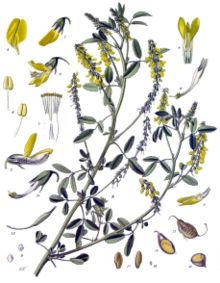- Melilotus
-
- This article is about the genus of grassland plants. For the moshav, see Mlilot.
Melilotus 
Melilotus officinalis Scientific classification Kingdom: Plantae (unranked): Angiosperms (unranked): Eudicots (unranked): Rosids Order: Fabales Family: Fabaceae Subfamily: Faboideae Tribe: Trifolieae Genus: Melilotus
L.Species See text
Synonyms Brachylobus Dulac (1867)[1]
Melilothus Homem. (1819)[1]
Meliloti Medik. (1787)[1]
Meliotus Steud. (1841)[1]
Sertula O. Ktze. (1891)[1]Melilotus, known as Melilot or Sweet Clover, is a genus in the family Fabaceae. Members are known as common grassland plants and as weeds of cultivated ground. Originally from Europe and Asia, it is now found worldwide.
Like the most fragrant of the plants called sweet grass, this clover is commonly named for its sweet smell, which in both plants is due to its high content of the perfume agent coumarin (which is bitter to the taste, and is probably produced by the plant to discourage ingestion by animals). Coumarin, in turn, is used by fungi to form a poisonous anticoagulant in moldly or spoiled sweet clover, called dicoumarol. This compound was the historical cause of so-called sweet clover disease, the analysis of which led eventually to the production of the warfarin family of anticoagulants.
Contents
Uses
Melilotus species are used as food plants by the larvae of some Lepidoptera species including case-bearers of the genus Coleophora that including C. frischella and C. trifolii.
Melilotus is often used as a green manure and turned into the soil to increase its nitrogen and organic matter content. It is especially valuable in heavy soils because of its deep rooting. However, it may fail if the soil is too acidic. It should be turned into the soil when 8 to 10 inches tall. Unscarified seed is best sown in spring when the ground is not too dry; scarified seed is better sown in late fall or even in the snow, so it will germinate before competing weeds the following spring.[2]
Others
Blue Melilot (Trigonella caerulea) is not a member of the genus, despite the name.
Species
The genus Melilotus currently has nineteen recognized species:[3]
- Melilotus albus Medik.
- Melilotus altissimus Thuill.
- Melilotus dentatus (Waldst. & Kit.) Pers.
- Melilotus elegans Salzm. ex Ser.
- Melilotus hirsutus Lipsky
- Melilotus indicus (L.) All.
- Melilotus infestus Guss.
- Melilotus italicus (L.) Lam.
- Melilotus macrocarpus Coss. & Durieu
- Melilotus officinalis (L.) Lam.
- Melilotus polonicus (L.) Desr.
- Melilotus segetalis (Brot.) Ser.
- Melilotus siculus (Turra) B. D. Jacks.
- Melilotus speciosus Durieu
- Melilotus spicatus (Sm.) Breistr.
- Melilotus suaveolens Ledeb.
- Melilotus sulcatus Desf.
- Melilotus tauricus (M. Bieb.) Ser.
- Melilotus wolgicus Poir.
References
- ^ a b c d e Woodgate, Katherine; Maxted, Nigel; Bennett, Sarita Jane (1996). "Genetic resources of Mediterranean pasture and forage legumes". In Bennett, Sarita Jane; Cocks, Philip Stanley. Genetic resources of Mediterranean pasture and forage legumes. Current Plant Science and Biotechnology in Agriculture. 33. Norwell, MA: Kluwer Academic Publishers. p. 203. ISBN 0-7923-5522-9.
- ^ Five Acres and Independence by M.G. Kains. 1973.
- ^ "Species Nomenclature in GRIN". http://www.ars-grin.gov/cgi-bin/npgs/html/splist.pl?7430. Retrieved 2010-08-04.
Categories:- Faboideae
- Medicinal plants
- Nitrogen-fixing crops
- Faboideae stubs
Wikimedia Foundation. 2010.
